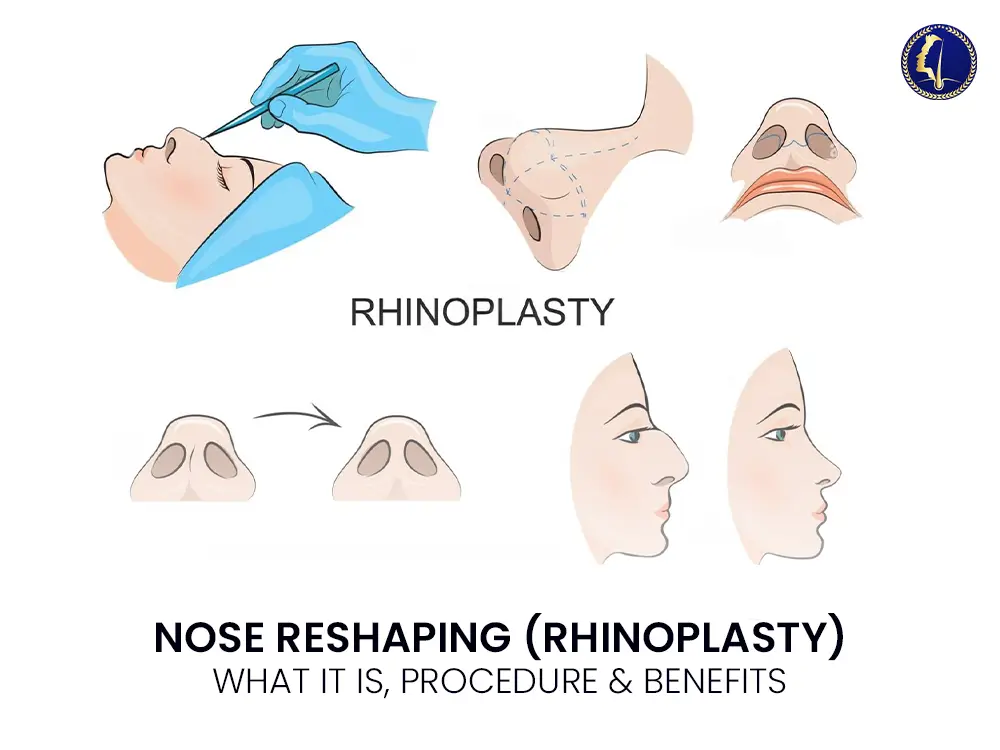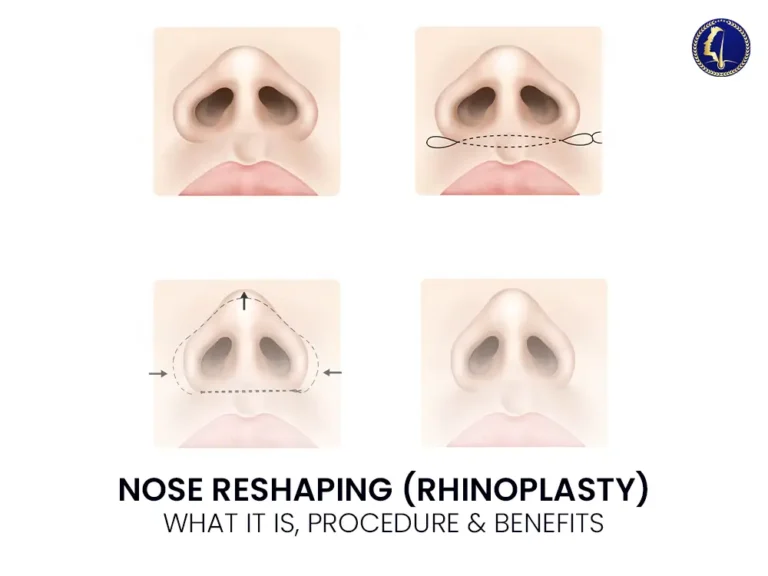Nose Reshaping
Nose reshaping, or rhinoplasty, is a cosmetic surgery procedure aimed at enhancing the appearance of the nose. Rhinoplasty, often referred to as a nose job, involves modifying the bone and cartilage structure of the nose to improve its shape, size, or function. This procedure is popular among individuals seeking to correct aesthetic concerns, restore facial harmony, or even address breathing difficulties caused by structural issues in the nose. Whether performed for cosmetic or medical reasons, rhinoplasty is a highly specialized surgery that requires a skilled surgeon to achieve natural-looking and functional results.
What Is Rhinoplasty?

Rhinoplasty, or nose reshaping surgery, is a procedure designed to alter the size, shape, or proportions of the nose. This surgery can be performed to enhance the nose’s appearance or to improve breathing by correcting structural issues. Common reasons for rhinoplasty include addressing congenital deformities, fixing broken noses, or correcting breathing problems due to a deviated septum. There are two main types of rhinoplasty: cosmetic rhinoplasty and functional rhinoplasty.
Cosmetic Rhinoplasty – This type of rhinoplasty focuses purely on improving the aesthetic appearance of the nose. Individuals seeking cosmetic rhinoplasty may want to reduce a bump on the nose, refine the tip, make the nose smaller or larger, or achieve better overall facial symmetry.
Functional Rhinoplasty – Functional rhinoplasty is typically performed to address breathing problems caused by structural issues such as a deviated septum, enlarged turbinates, or nasal blockages. In many cases, functional rhinoplasty is combined with cosmetic rhinoplasty, offering both aesthetic and functional benefits.
Why Do People Choose Rhinoplasty?
There are many reasons why individuals opt for rhinoplasty, and these reasons can be either aesthetic or functional:
Aesthetic Concerns: Many people choose rhinoplasty to correct perceived flaws in the appearance of their nose. For instance, if a person has a prominent hump on the nose, a bulbous tip, or a crooked nose, rhinoplasty can reshape these features for a more balanced and natural look that better complements their facial features.
Breathing Issues: Rhinoplasty is often sought after by individuals who have trouble breathing due to a deviated septum, enlarged turbinates, or nasal blockages. These issues can lead to difficulty breathing through the nose, and rhinoplasty can help correct these problems, improving both airflow and overall quality of life.
Injury or Trauma: A nose injury, such as a broken nose, may require rhinoplasty for both functional and aesthetic reasons. After an injury, the structure of the nose may be altered, leading to breathing problems or changes in appearance that the individual wants to correct.
Improving Facial Harmony: For many individuals, the nose plays a central role in their overall facial harmony. Rhinoplasty allows patients to achieve a more balanced and proportional facial appearance by reshaping the nose in a way that enhances their natural beauty.
What Happens During Rhinoplasty Surgery?
Rhinoplasty is typically performed under local or general anesthesia, depending on the complexity of the procedure. The surgery involves making incisions either inside the nostrils (closed rhinoplasty) or across the base of the nose (open rhinoplasty). The approach depends on the extent of reshaping required.
Closed Rhinoplasty: In closed rhinoplasty, all incisions are made inside the nostrils, leaving no visible scars on the external surface of the nose. This method is usually recommended for patients who need minor adjustments to the shape or structure of the nose.
Open Rhinoplasty: In open rhinoplasty, an incision is made across the columella (the tissue between the nostrils), which allows the surgeon to lift the skin of the nose and gain better access to the underlying bone and cartilage. This approach is typically used for more complex rhinoplasty procedures where significant reshaping is needed.
After the incisions are made, the surgeon carefully sculpts the bone and cartilage to achieve the desired shape. In some cases, cartilage may be taken from other parts of the body, such as the ear or rib, to provide better structure for the nose. Once the necessary changes are made, the incisions are closed, and the nose is stabilized with splints and dressings.
Recovery After Rhinoplasty
The recovery period after rhinoplasty varies from patient to patient, but in general, patients can expect the following:
Swelling and Bruising: Swelling and bruising around the nose and eyes are common after rhinoplasty. This typically peaks within the first two to three days and gradually improves over the next few weeks.
Nasal Congestion: Some patients experience nasal congestion due to the swelling of the nasal passages. This can last for a few weeks after the surgery.
Post-Surgical Care: Patients are usually advised to keep their head elevated during the first few days after surgery to minimize swelling. It is important to avoid strenuous activities and refrain from blowing the nose during the initial recovery phase to prevent complications.
Return to Work and Activities: Most patients can return to work or school within one to two weeks, though strenuous physical activities and exercise should be avoided for at least four to six weeks.
Final Results: The full results of rhinoplasty may take several months to fully reveal themselves, as swelling can take time to subside. However, many patients begin to see improvements in the shape and function of their nose within a few weeks after surgery.
Costs of Rhinoplasty in Asia
The cost of rhinoplasty can vary significantly depending on the country, the surgeon’s experience, and the complexity of the procedure. In Asia, the cost of rhinoplasty generally ranges as follows:
Thailand: Rhinoplasty in Thailand is popular due to its high-quality procedures and relatively lower costs. The cost of rhinoplasty in Thailand typically ranges from 90,000 to 210,000 Thai Baht (THB), which is approximately $2,500 to $6,000 USD.
South Korea: South Korea is known as a global hub for cosmetic surgery, particularly rhinoplasty. The cost of rhinoplasty in South Korea ranges from 4,500,000 to 10,500,000 Korean Won (KRW), which is about $4,000 to $8,000 USD.
Malaysia: In Malaysia, rhinoplasty procedures typically cost between 8,000 to 20,000 Malaysian Ringgit (MYR), which is approximately $2,000 to $5,000 USD. Malaysia offers competitive prices with high-quality services, making it a popular destination for medical tourism.
Singapore: Singapore is known for its top-tier medical facilities and skilled surgeons, with rhinoplasty surgeries costing between 6,000 to 16,000 Singapore Dollars (SGD), which is around $5,000 to $12,000 USD.
India: India is another popular destination for rhinoplasty, offering high-quality surgery at more affordable rates. The cost in India generally ranges from 100,000 to 300,000 Indian Rupees (INR), which is approximately $1,500 to $4,000 USD.
Risks and Complications
As with any surgical procedure, rhinoplasty carries certain risks and potential complications, including:
Infection: Although rare, infection can occur after surgery and may require treatment with antibiotics or additional surgery.
Bleeding: Excessive bleeding can occur during or after surgery, though this is typically managed by the surgeon.
Nasal Obstruction: In some cases, the reshaping of the nose can cause difficulty breathing if the nasal passages are narrowed or blocked.
Unsatisfactory Results: While rhinoplasty is generally effective, there is always a risk that the final results may not meet the patient’s expectations. In some cases, a revision surgery may be required to refine the results.
5 FAQs About Rhinoplasty
1. Who is a good candidate for rhinoplasty?
A good candidate for rhinoplasty is someone in good overall health, with realistic expectations about the outcome of the surgery. It is important for candidates to be physically mature, as the nose continues to develop until the late teens or early twenties.
2. How long does the rhinoplasty procedure take?
The duration of the procedure depends on the complexity of the surgery. On average, rhinoplasty can take anywhere from one to three hours.
3. Will rhinoplasty leave scars?
While rhinoplasty may leave scars, especially with the open technique, they are typically hidden inside the nostrils or along the base of the nose, and they usually fade over time.
4. Can rhinoplasty fix breathing problems?
Yes, rhinoplasty can be performed to correct breathing problems caused by a deviated septum or other nasal obstructions. Functional rhinoplasty is designed to improve airflow through the nose.
5. How long does it take to recover from rhinoplasty?
Recovery time varies, but most patients can return to work or school within one to two weeks. Swelling and bruising may last several weeks, and full recovery can take up to a year to see the final results.
Rhinoplasty can significantly enhance your facial aesthetics and improve nasal function, offering both cosmetic and medical benefits. However, it’s important to consult with an experienced surgeon who specializes in rhinoplasty to discuss your goals, risks, and expected outcomes before undergoing surgery.
Nose reshaping is a sought-after cosmetic procedure that allows individuals to improve the appearance of their nose. Whether you want to address aesthetic concerns or correct structural issues, nose reshaping can offer significant benefits. For those seeking to alter the shape, size, or proportions of their nose, nose reshaping provides an opportunity to enhance facial harmony. This procedure is not just about making the nose look better but can also serve functional purposes, such as improving breathing. With modern techniques in nose reshaping, patients can achieve more natural-looking results, tailored to their unique facial structure.
Choosing nose reshaping means taking a step toward a more balanced and confident appearance. Many people opt for nose reshaping when they feel their nose doesn’t fit well with the rest of their face. The decision to undergo nose reshaping should be carefully considered, as it involves both cosmetic and medical aspects. It’s important to consult with a skilled surgeon who can guide you through the process, ensuring that the outcome of your nose reshaping meets your aesthetic and functional goals.
